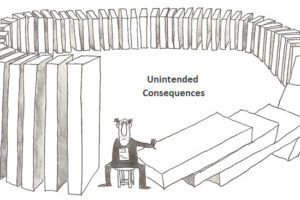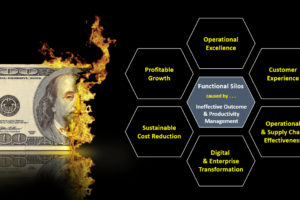Headline:
Maximizing the value and benefits of Integrated Reporting, while instilling integrated thinking into organizations, requires an ability to embed underlying concepts in (strategic, financial and operational) planning and performance management (P&PM) processes.
Introduction:
The International Integrated Reporting Council (IIRC) describes Integrated Reporting, Integrated Reports and Integrated Thinking (IT) as follows:
-
-
-
-
- Integrated Reporting (IR) is a process founded on integrated thinking that results in a periodic integration report by an organization about value creation over time and related communications regarding aspects of value creation.
- An integrated report is a concise communication about how an organization’s strategy, governance, performance and prospects, in the context of its external environment, lead to the creation of value in the short, medium and long term
- Integrated thinking is a multi-capital management approach that enables organizations to deliver their purpose to the benefit of their key stakeholders overtime. It is about creating and preserving value and enabling better decision-making based on interconnected, multi-capital information
-
-
-
Fundamental Questions:
Establishing greater traction for IR and IT requires the ability to answer a number of fundamental questions, which a shown below, expressed in both summarized and detailed versions:
-
-
-
-
- What’s the value? How do IR and IT create business value and where does this value lie?
- What’s new? What new capability results from integration that creates this value?
- What’s in it for me? How do IR and IT address business challenges that are important to key stakeholders?
- What Is fully integrated? How is IR and IT different than the myriad of other integration-related P&PM approaches and terms being advocated software companies and other interest groups?
- What enables mature integration? What technologies enable global organizations to effectively implement mature P&PM processes and thereby support IR and IT?
- What do mature processes look like? What steps comprise mature P&PM processes and what should these processes look like, in non technical and observable terms?
-
-
-
The answers to these questions are provided below, together with links to supporting blog posts and videos that explain key perspectives in more detail. Note that some links are mentioned more than once, as they address multiple questions. Also, certain links are noted as TBD since they are in the process of being published
What’s The Value?
The best way of getting traction for any initiative is by defining how it creates value. And more specifically, how this value is greater than other investment opportunities. In this context, mature forms of IR and IT represent one of the single greatest sources of value for global organizations because it enables them to effectively manage complexity, the cost of which can approach 5% of sales. The following blog posts describe this value and provide evidence of its existence:
-
-
-
-
- Research Study Results Exposing Value Erosion Caused By Complexity (Click Here to View)
-
-
-
-
-
-
-
- Achieving dynamic cost optimization in global manufacturers (TBD)
-
-
-
Note that Strategic IBP is a manufacturing-specific term describing the most mature form of integrated process.
What’s New?
What underlies this value is one capability that most global organizations lack. That being a formal mechanism for optimizing enterprise performance. Such a mechanism provides the means to promote decisions that balance the interests of all stakeholders – one of the fundamental principles of IR and IT.
Maintaining such balance requires managing objectives that often conflict with one another. In other words, organizations must be capable of planning and managing tradeoffs, at all levels. This is achieved by doing three things:
-
-
-
-
- Making outcomes and business processes the central integrating structure for P&PM processes
- Connecting all financial and non-financial to tradeoffs related to each outcome
- Establishing horizontal planning processes that connect outcomes to functional resources
-
-
-
What results are mature forms of integrated P&PM processes that embed IR principles. By doing so, organizations can establish formal mechanisms for aligning, balancing and optimizing:
-
-
-
-
- Functional, process and entity performance
- Financial and non financial targets that comprise tradeoffs
- High and low level tradeoff targets, across functions and legal entities
- Short and long term targets
-
-
-
This incremental capability plays a central role in managing the six types of capital described by the IIRC. This includes Financial, Manufactured, Intellectual, Human, Natural and Social and Relationship. It also provides the means to balance value creation between shareholders, customers and suppliers. The following blog post describe these incremental capabilities in more detail:
-
-
-
-
- Four Critical Capabilities For Planning, Managing & Governing Performance (Click Here to View)
-
-
-
What’s In It For Me?
Embedding integrated thinking into organizations is a significant undertaking. It will have far reaching affects that impact virtually every key stakeholder. A key component of every change plan will be to articulate how key stakeholder will benefit from it. The following is examples of how key stakeholders will benefit from it.
Operational excellence is a something that many organizations are pursuing. However, few are fully realizing its potential. One reason is that financial P&PM processes don’t support an outcome-based approach. Instead, they reinforce functional silos. The following blog post describes this challenge in more detail and how mature forms of integrated processes can address this issue:
-
-
-
-
-
- Institutionalizing Operational Excellence & Eliminating Functional Silos (Click Here to View)
-
-
-
-
Financial executives have made significant investments in P&PM technologies to improve financial processes. However, they still struggle to establish rolling forecast processes that provide accurate cash flow forecasts and effective scenario planning. In fact, cash flow forecasting remains one of the most immature processes in global manufacturers. The article below explains of mature P&PM processes can accomplish this and what these processes are worth:
-
-
-
-
-
- Mature cash flow forecasting can increase profits by 5% of sales (Click Here to View)
-
-
-
-
Integrated Business Planning (IBP) is an objective of many global manufacturers. However, it is not delivering expected benefits and value. Primarily because IBP, as it is know today, represents immature an form of strategic, financial and operational P&PM integration: The articles below explain how mature P&PM processes can address this and what these processes are worth:
-
-
-
-
-
- Strategic IBP driving profitable growth in complex global organizations (Click Here to View)
- Strategic IBP driving profitable growth in complex global organizations (Click Here to View)
-
-
-
-
Following from the above, there is a lack of understanding within finance functions about the capabilities underlying fully integrated processes and what they entail. This is especially relevant in manufacturing organizations where Integrated Business Planning (IBP) often fails to deliver expected value and benefits. The following blog post describes this in more detail:
-
-
-
-
-
- Maximizing IBP Value And Benefits To Finance (Click Here to View)
-
-
-
-
What Is Fully Integrated?
One critical challenge stands in the way of effectively embedding IR and IT into the processes organizations use to plan, manage and govern enterprise performance. There is no universal definition of what constitutes fully integrated processes. What results is confusion about what this term means. The following blog posts describe a maturity model that defines mature forms of P&PM processes and the critical capabilities that comprise them.
-
-
-
-
-
- Integrated planning and performance management maturity model (Click Here to View)
- Institutionalizing Operational Excellence & Eliminating Functional Silos (Click Here to View)
- Four Critical Capabilities For Planning, Managing & Governing Performance (Click Here to View)
- What Is The Difference Between IBP & IFP? (Click Here to View)
- Integrated planning and performance management maturity model (Click Here to View)
-
-
-
-
What Enables Mature Integration?
In global manufacturers, one of the key technologies required to support mature forms of P&PM integration is prescriptive analytics. Institutionalizing IR and IT will be difficult to achieve without it. While the technologies required to support such processes currently exist, they are not supported by (so called) financial and operational P&PM technology leaders. The following blog posts provide insight into this technology issue:
-
-
-
-
-
- Mature cash flow forecasting can increase profits by 5% of sales (Click Here to View)
- Improving cash flow forecasting requires both predictive and prescriptive analytics (TBD)
- Realizing the full potential of prescriptive analytics requires effective platforms (Click Here to View)
-
-
-
-
What Do Mature Processes Look Like?
The nature of integrated P&PM processes varies depending on the person with whom one discusses the topic. What’s more, experts often use a lot of technical jargon to describe their view of these processes. A simpler way of describing mature forms of integrated processes is to describe what one won’t find it these processes. The following blog post provides such a description of these processes:
-
-
-
-
-
- What do mature forms of integrated planning & performance management processes look like? (TBD)
-
-
-
-
In so doing, this blog also describes the tactical value proposition for mature forms of integrated P&PM processes. Such processes can reduce the cost of planning and managing a business by up to 50% because they eliminate non valued added activities and redundant software capabilities.



